Personal Training Website Ideas
If you really want to progress your career in personal training – either as a trainer or a fitness guru – there’s no better place to get exposure than your website.
A personal trainer’s website can be the place where they attract clients, share their expertise about fitness and wellness, reach a global audience, and promote their personal brand.
But I’m not going to lie, the health and fitness industry is saturated with 100s, if not 1,000s, of websites all vowing for a piece of the market, making it all the more difficult to make your site stand out.
Below we will take a look at some various personal trainer website ideas that will give you an edge on the competition and help you to progress your personal training career and personal brand to heights you never thought possible.

Effective Website Marketing from Other Popular Personal Trainers
A good place to start for personal trainer website ideas is to look at what some other successful trainers have done with their sites. Here are some examples of marketing strategies and designs that help them convert website visitors into clients.
Email Lead Capture
Did you know that 91 percent of consumers check their email daily, 74 percent prefer to receive communications via email, and 66 percent have a made a purchase as a result of an email marketing message?
These are just a few of the amazing statistics behind email marketing that make it so important to your success. When a potential lead visits your site, odds are they won’t just pick up the phone and schedule a meeting with you.
However, if you can capture their email you can continue to stay in front of them with your blog or other interesting workout-related content and eventually build their trust.
Here are a few examples of email lead capture from other personal xenical in usa trainers that are a good idea to implement into your personal training website:
Examples of Email Lead Capture
Right when you get to the http://tonygentilcore.com/ website one of the first things you see is your opportunity to get “fresh content.” A blog subscription is one of the ways Tony is getting leads who, over time, will learn to trust Tony while he stays top-of-mind each time they get an email with great content from him.
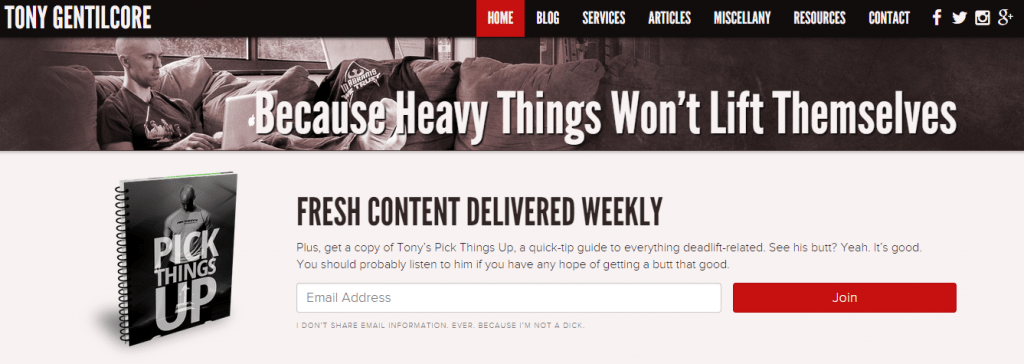
Another example of effective email lead capture is from the http://www.ericcressey.com/ website. Right when you get to the homepage this popup comes up with a free offer incentivizing something valuable – a free deadlift tutorial – in exchange for your email.
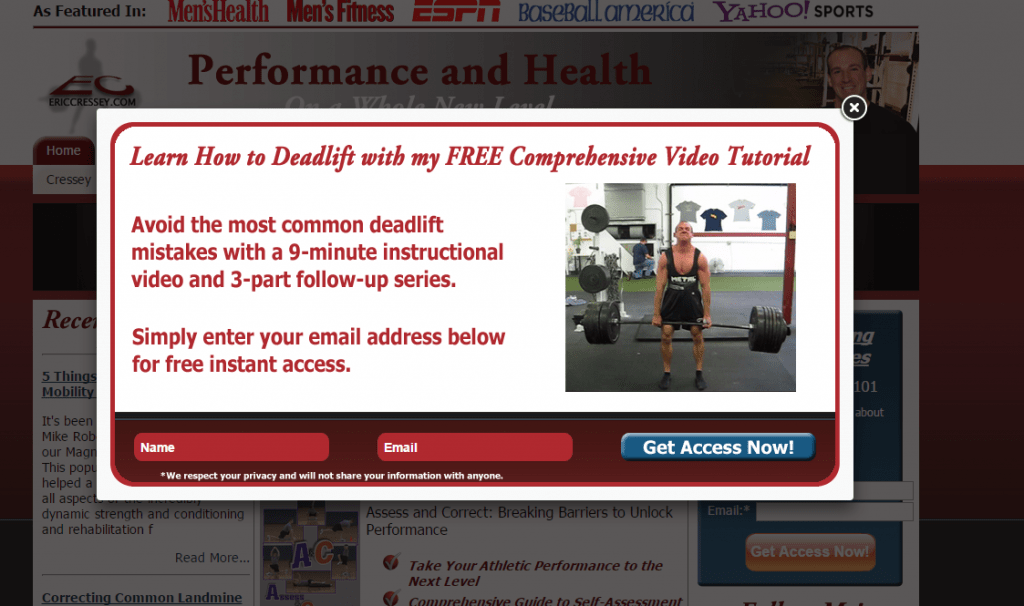
Podcast Lead Capture
If blog writing or the creation of video tutorials is not your thing, consider doing what http://www.jcdfitness.com/ did and create a podcast. You’ll be able to speak your mind and do things like JC where you field questions from your audience.
Plus you can post podcasts on iTunes and get even more exposure from searches there. Learn more about starting a podcast and marketing it here.

Use Social Proof
Although most new sites or trainers won’t have the kind of media exposure as John Romaniello of Roman Fitness Systems, any indications of your credibility as a personal trainer will help earn the trust of potential clients visiting your site.
This site, and many others, use the “As seen in” section in a place that is visible on their homepage to build instant credibility.
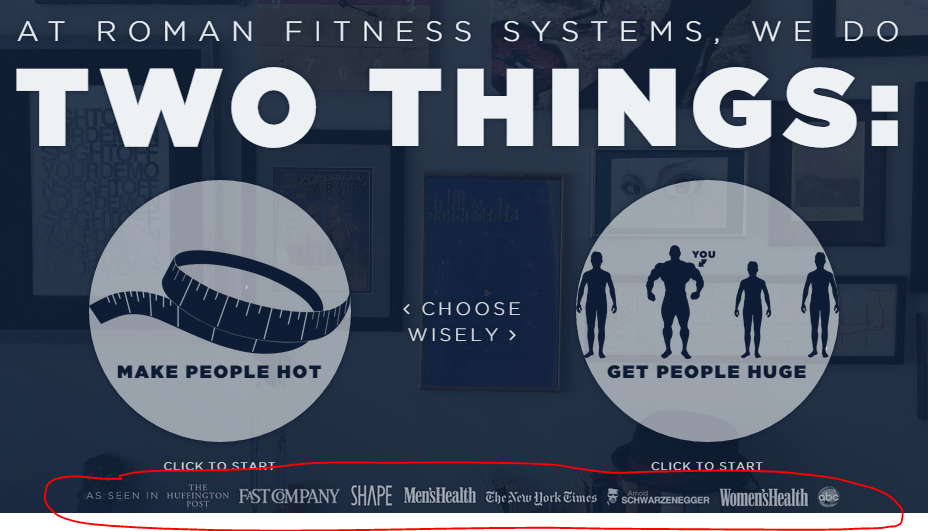
Social proof is not just limited to media exposure however, nearly any personal trainer can take advantage of the type of social proof that personal trainer Neghar Fonooni establishes on her http://www.negharfonooni.com/ site.
She uses testimonials to showcase what real people have said about her and backs up her results with actual before and after pictures of clients. This way her results can speak for themselves.
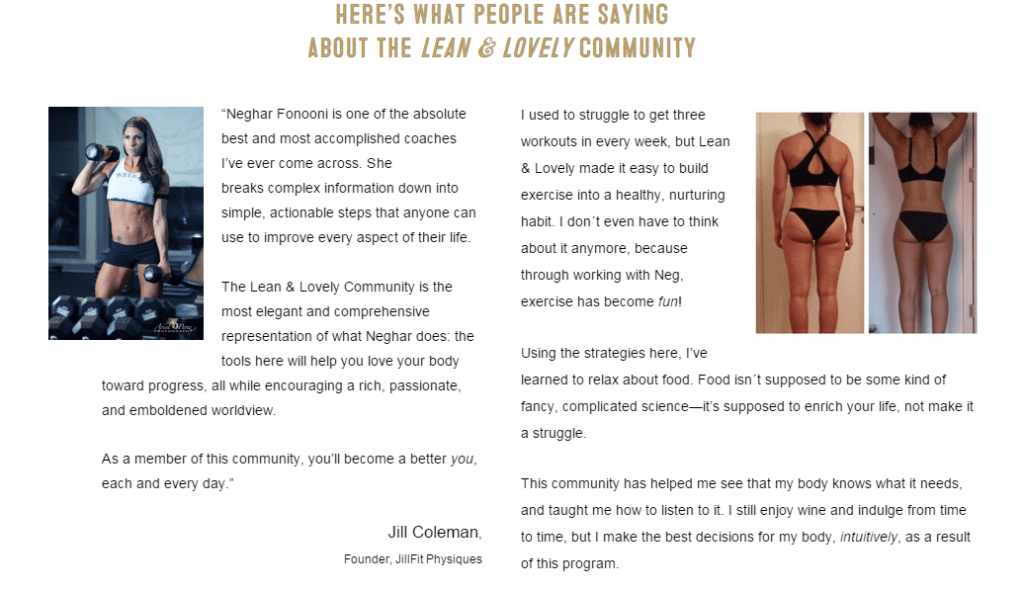
The Call-to-Action (CTA)
The CTA of a website is one of the most important components. It has been said that the average person now has the attention span of about 2.5 seconds, less than that of a goldfish.
When someone lands on your website you need to do two things, fast:
- Let them know what your site’s all about (in under 3 seconds)
- Tell them what to do next
Let’s look at some examples of sites that have strong CTAs.
The site http://jasonferruggia.com/ has a really simple, yet genius homepage that helps Jason do a few things:
- The “Why You’re Not Making Any Gains” appeals to people who can relate to that and lets them know what the site is all about – helping clients get gains.
- The huge “Get Exclusive Content” button tells you exactly what you will be getting if you subscribe to the blog.
- By subscribing, Jason is also gathering lead information.
- Below the lead capture section we also see the often used social proof element of “As featured in…” that adds credibility.
Good job Jason!
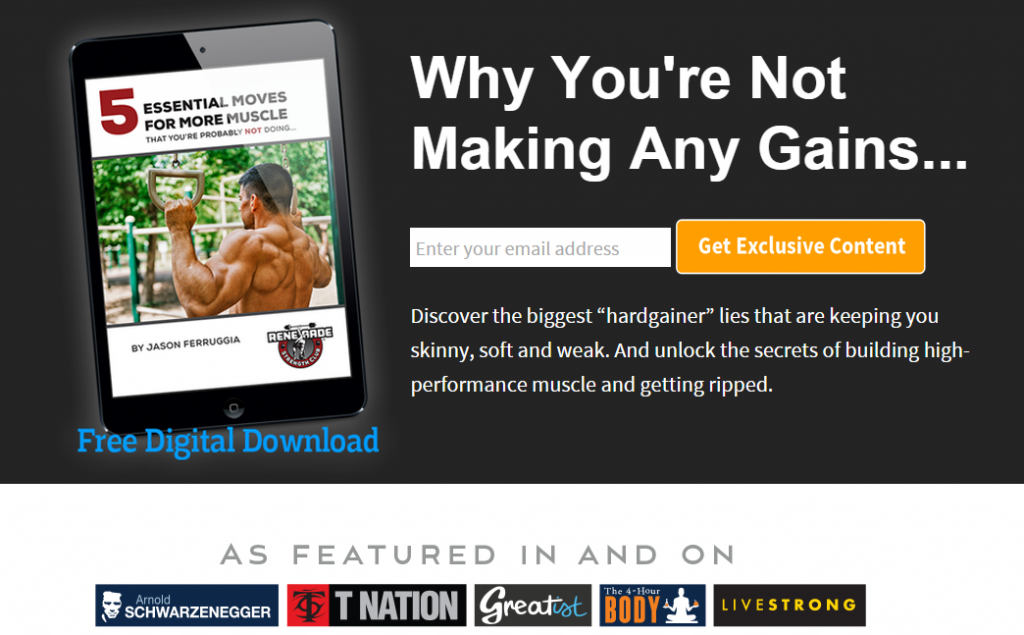
Again we look at the Roman Fitness Systems site, one of my favorites in terms of leading the customer down a path. For personal trainers who are just starting out or are not selling specific workout materials or products online, this is a good site to emulate.
In terms of the CTA, there are two:
- “Start Here”: It’s so simple yet efficient at helping guide people through the site. If you are a trainer and want to let people know where to find out more information about you, use your own “start here” button to lead them down your sales path.
- Two options: Also very simply done is the option to either get hot or get huge. This too is a CTA that helps lead people down a very specific sales path.

One thing you may have noticed from the above examples is that some personal trainers monetize their sites in different ways. That is something you’ll also have to consider when building your website.
Deciding on the Type of Site You Want
to PromoteJust like there are different types of personal trainers there can be different types of personal training websites. Obviously there can be some overlap between different areas of health and fitness but it’s usually easier to start narrow and deep rather than go broad and shallow.
Here are the three main types of personal trainer sites that you’ll want to consider and an explanation of their purpose:
- Client-centric and local: this is the type of site you’ll want to build if your goal is to get new personal training clients in your local area.
- Topic-specific: these sites focus on specific topics – like strength training, weight loss or bodybuilding – and usually have some type of monetization strategy that doesn’t involve one-on-one or group personal training.
- Brand-specific: the other type of personal training site is the brand-specific site. As the name implies, these are for brands with multiple trainers and/or facilities.
Client-centric and Local Personal Trainer Websites
With this type of website your main goal is to have people who are searching for personal trainers to find you or to have a place to collect leads. Here are some tips to have success with this type of website:
- Get a professionally-designed personal training website: your website is a reflection of your brand and is also a reflection of the type of work you provide. If you have a badass website with cool pictures, lots of information on your process and other trust-building signals, you’ll look as if you have a successful personal training business even if you’re just starting out.
- Don’t just build a site, build your personal brand: when building your client-facing site, you’ll have to consider how you’ll sell your fitness theory. This means having your website describe the following items so that clients know what to expect from you and can get excited about working with you:
- What health means to you
- What your daily routine is to promote health
- What you eat and why
- Your strategies to create a new habit or behavior
- What exercises you use to get in the best shape
- Marketing your website (SEO): the easy way to market your website is through your personal interactions, with business cards and through word-of-mouth referrals. But the long-term and personal-training-website-marketing-that-should-be-on-your-radar will come in the form of what’s called search engine optimization, or SEO. SEO, a form of marketing that sees your website will be found by people who are searching for personal trainers on search engines, is like personal training for websites. It helps them get strong, get attention, and become sexy in the eyes of Google. SEO will be one of your greatest assets if you are trying to get new clients on a continual basis.
For an example of a client-centric personal training website check out http://www.eddielester.com/, the website of Fitness Mentors founder Eddie Lester. Eddie’s site does a few things right: first, it is clear that it was designed by professionals and not by amateurs. Second, Eddie’s website focuses on images to tell the picture of what he is selling.

Thirdly, Eddie has a robust About page that talks about his background and as well as his certifications.
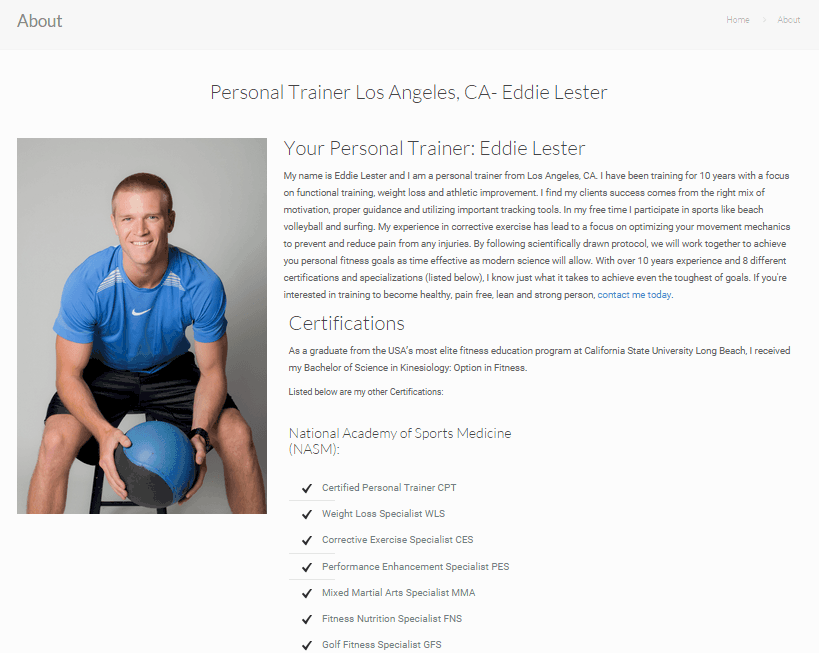
Fourth, Eddie makes good use of the services page and speaks about the services that are unique to his business. He also mentions his price points, something that most potential clients will want to know right off the bat.
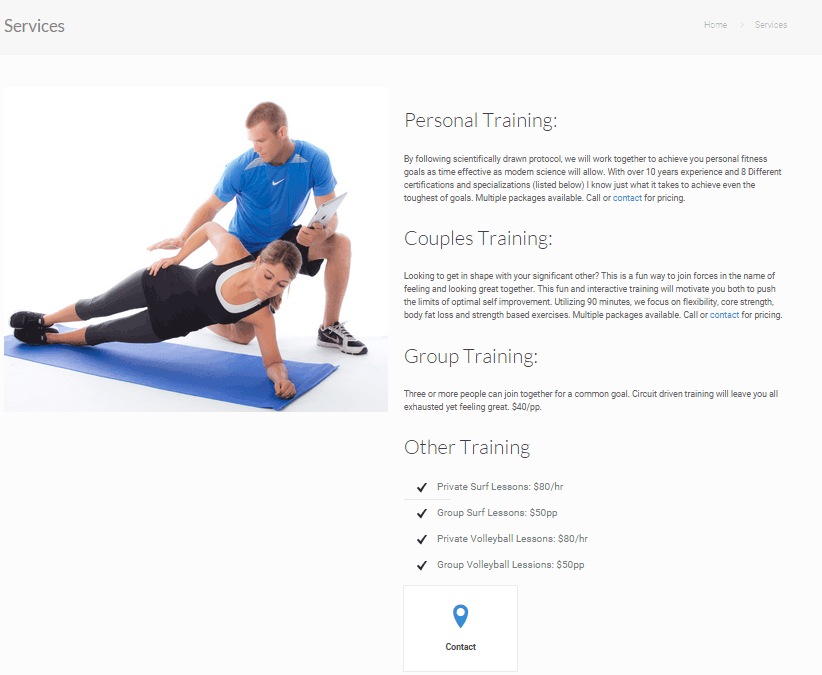
Finally, Eddie adds social proof with an up-to-date testimonial page. His contact information is also clearly displayed so that people can get in touch with him via phone, email or through social media.

Topic-specific Personal Training Websites

One of the other, and perhaps most competitive, of personal training websites are the ones that cover specific topics. You know these sites well because the popular ones come up again and again when you do fitness-related searches.
These types of sites include, for example, Bodybuilding.com, MuscleandFitness.com, Shape.com and the more individualized versions of these sites like RomanFitnessSystems.com or JillianMicheals.com.
The difference between these websites and client-centric sites is that they create revenues in a different way than individual or group personal training sessions. In other words you can’t actually hire the trainers on these sites, they exist to sell you on something else.
What do these topic-specific sites sell? Let’s take a closer look at the examples of the sites to see if any of these relate to what you’d like to achieve:
- com: Sells supplements from is online store.
- com: Sells advertisements and magazine subscriptions as well as supplements.
- com: Sells advertisements and magazine subscriptions.
- com: Sells online coaching, books and gadgets.
- com: Sells diet and exercise plans and ads.
While many of these sites feature personal trainers, the end goal of the sites is not to help the visitor’s book sessions with them. The personal trainers are mainly responsible for the content on the site or have a reputation that they use to sell products they put their names on.
If you are not yet a big name personal trainer but want to create a website that is monetized some other way, here are some website ideas that will get you on your way:
- Amazing personal training websites start and end with great content: with the exception of Jillian Michaels site, all of the abovementioned sites all got to where they were by creating amazing content. Take Bodybuilding.com for example, do a Google search for almost any topic on workouts and you’ll find them in the first or second spot. This is because their content is superior to almost anything else on the web. This doesn’t only apply to written form, they also have loads of videos, pictures, graphs and illustrations to make their content even more appealing. Furthermore, the writers on their site are true authorities in the health and fitness field which only leads to their credibility.
If you are going to create a website with the goal of selling products or ads, you can follow Bodybuilding.com’s model of putting the content on your shoulders and moving ahead from there.
- Outreach is just as important as content creation: after you begin to create really great content for your website you’ll want to start the outreach portion. Unlike in Field of Dreams, the “if you build it they will come” idea doesn’t work on websites. One way to start is to spread the word on social media but where you’ll really have success is by forming relationships with other personal trainers who have bigger networks. Asking them to share your content on their social networks is one way to get more eyeballs on your content and to expand the reach of your content.
Traffic is the Most Important Thing for Monetizing Topic-specific Personal Training Websites
The amount of visitors you get to any website is important but this is especially true for these topical sites. This is because the amount of ads you sell, or the amount of meal plans you sell, or the amount of books you sell, etc. will depend on your ability to drive big numbers of visitors to your site.
For comparison sake, the personal trainer who gets 1,000 people to visit their site will probably gain the interest of about 10%, or 100 of those people. Then, only about 10% of those 100, or 10 people might actually reach out to that personal trainer. If he or she is a good closer, they can expect to turn 10% of those 10, or 1, into a client.
But one new client a month for a personal trainer is probably something that could sustain a business that already had a decent number of clients (but not an entirely new business).
With a topic-specific personal training site you’ll need to have a lot more traffic to keep the money coming in which is why these types of sites are amongst the most challenging. As a rule of thumb, you’ll probably need to get your topic-specific personal training website into the 100,000 visitors per month range before you really start monetizing it.
For comparisons sake, Bodybuilding.com gets about 26 million hits per month and RomanFitnessSystems.com about 200,000 based on traffic estimates from https://www.websiteiq.com/.
In this case, you’ll probably also want to invest in search engine optimization marketing if you are looking to monetize your site.
Brand-specific Personal Training Websites

These are the types of websites that are for multi-trainer personal training companies or for the personal trainer who has aspirations of growing their business beyond themselves.
Like the client-centric sites, these tend to market to clients in the local area but can grow to farther reaching chains not unlike a CrossFit or similar gym. These sites can also venture into group training or other trendy workout movements like yoga, Pilates or even sport-specific training.
Because the focus of these types of businesses tends to be narrow and deep, these websites should focus on the following approach:
- A full explanation of the benefits: when people look for a specific type of training they are either a) very interested in that type of training and need to be persuaded why they will try it for the first time with you, or b) already love this type of training but need a reason to visit your facility/gym/experience to convince them it may be better than what they have done before.
- Lots of pictures: going along with the above, making the change to your business is going to take some visuals of your operations to help seal the deal. Your website should be highly visual with professional-grade photographs of your equipment, people doing exercises and perhaps most importantly, the trainers who dedicate their lives to helping others.
You’ll Want Online Exposure Here Too
Yup, it’s that word again, SEO, the one you knew was coming. If you want more exposure than what you’re going to get from word-of-mouth you’ll want to take advantage of search engine optimization.
SEO will help you to rank for your specific services so that people who want them and don’t know about your brand will find you, call you and contribute to your continued success.
Personal Training Website Ideas Recap
Now you have learned a few things about personal trainer websites. You should be able to take this knowledge and decide the type of lead capture, marketing tools or call-to-actions you want to use.
You should also know the type of personal trainer website you want: local, topic-specific or brand-specific.
With these fundamentals you’ll be able to build a better website and a better career. Don’t forget, you can get a professionally-made website from a name you can trust – Fitness Mentors.

Personal Trainer Career Roadmap
Featured Posts

How to Become a Personal Trainer in 5 Simple Steps

Personal Trainer in 2020

Personal Trainer Salary

Top 5 Exercise Science Careers





